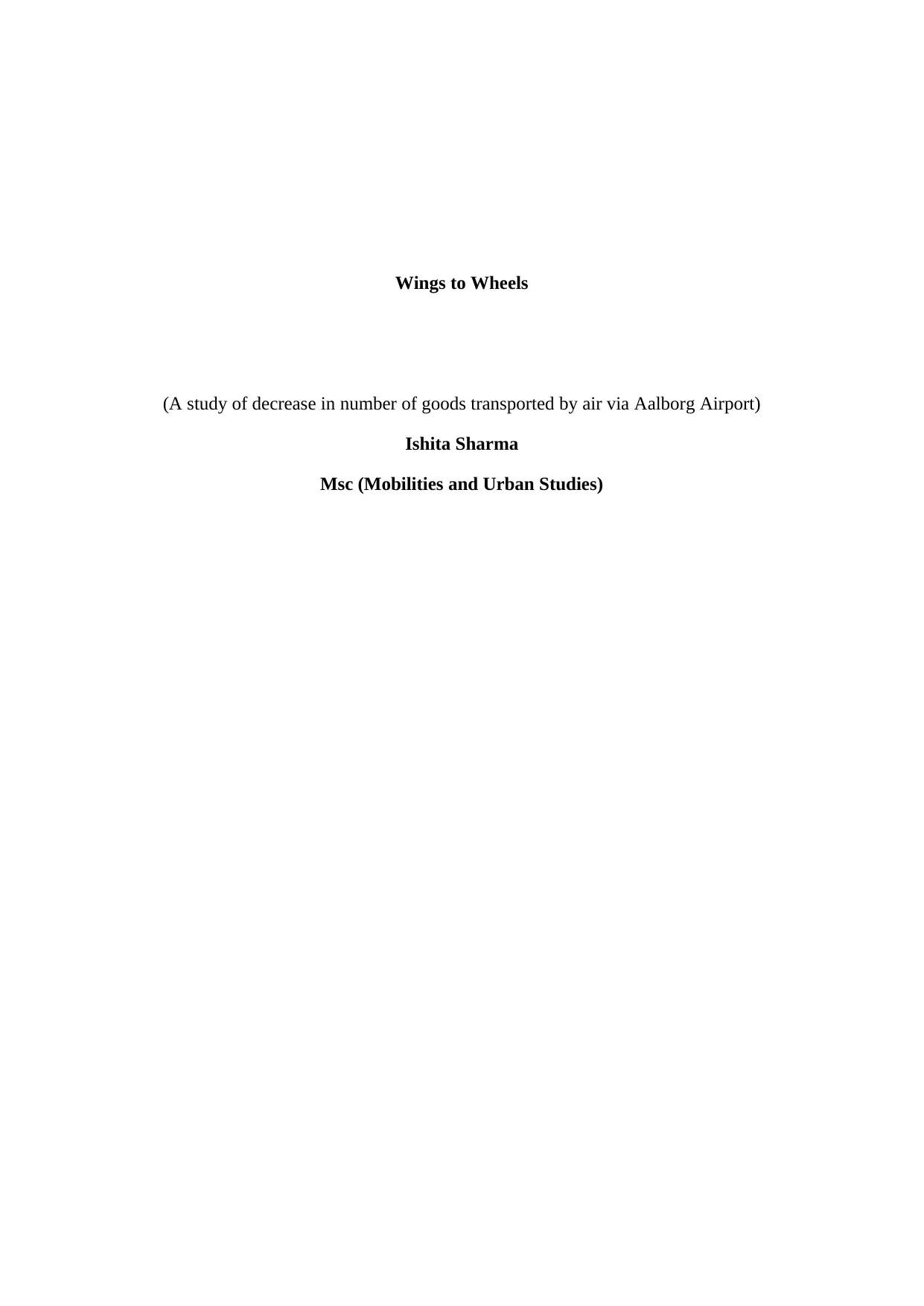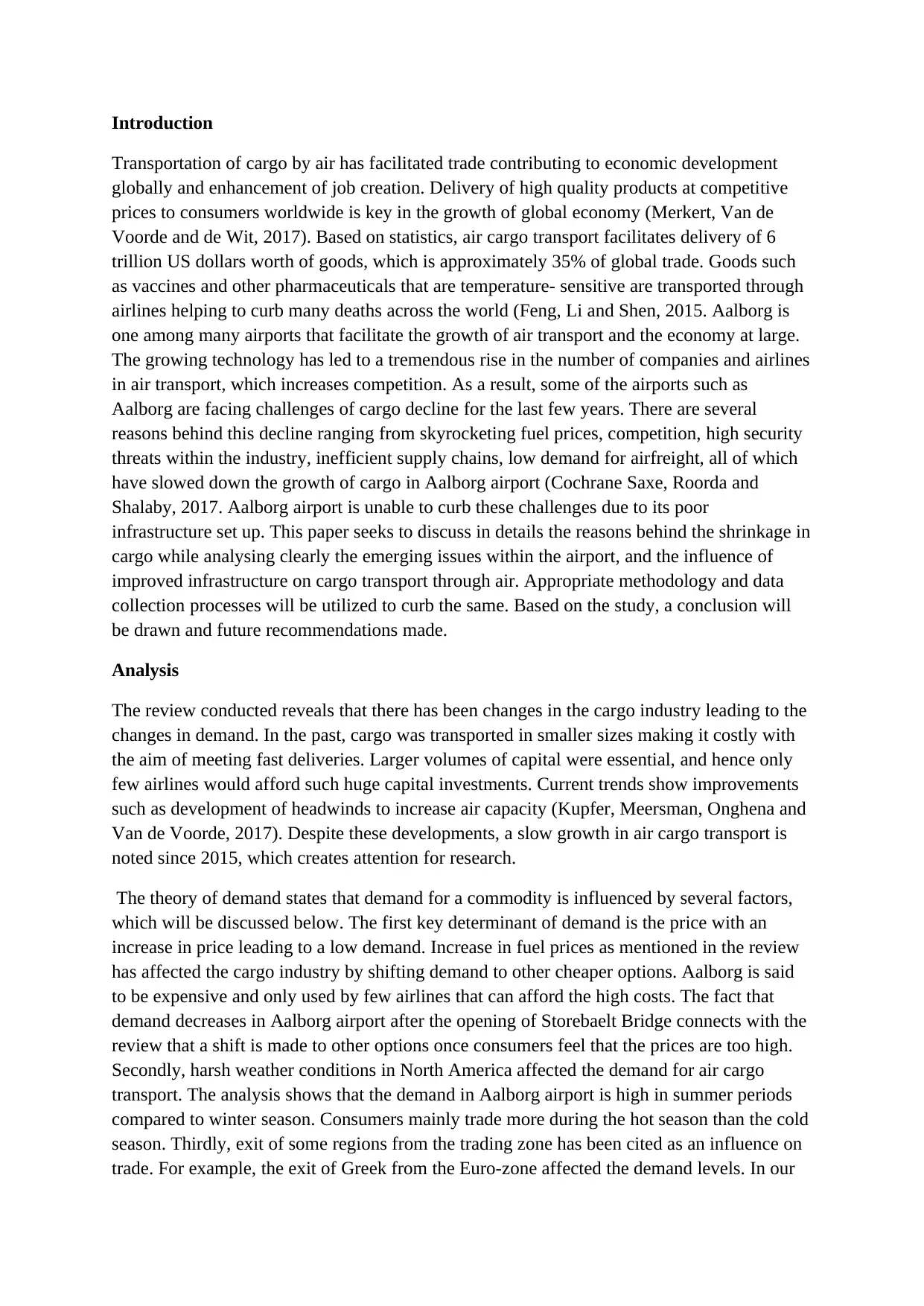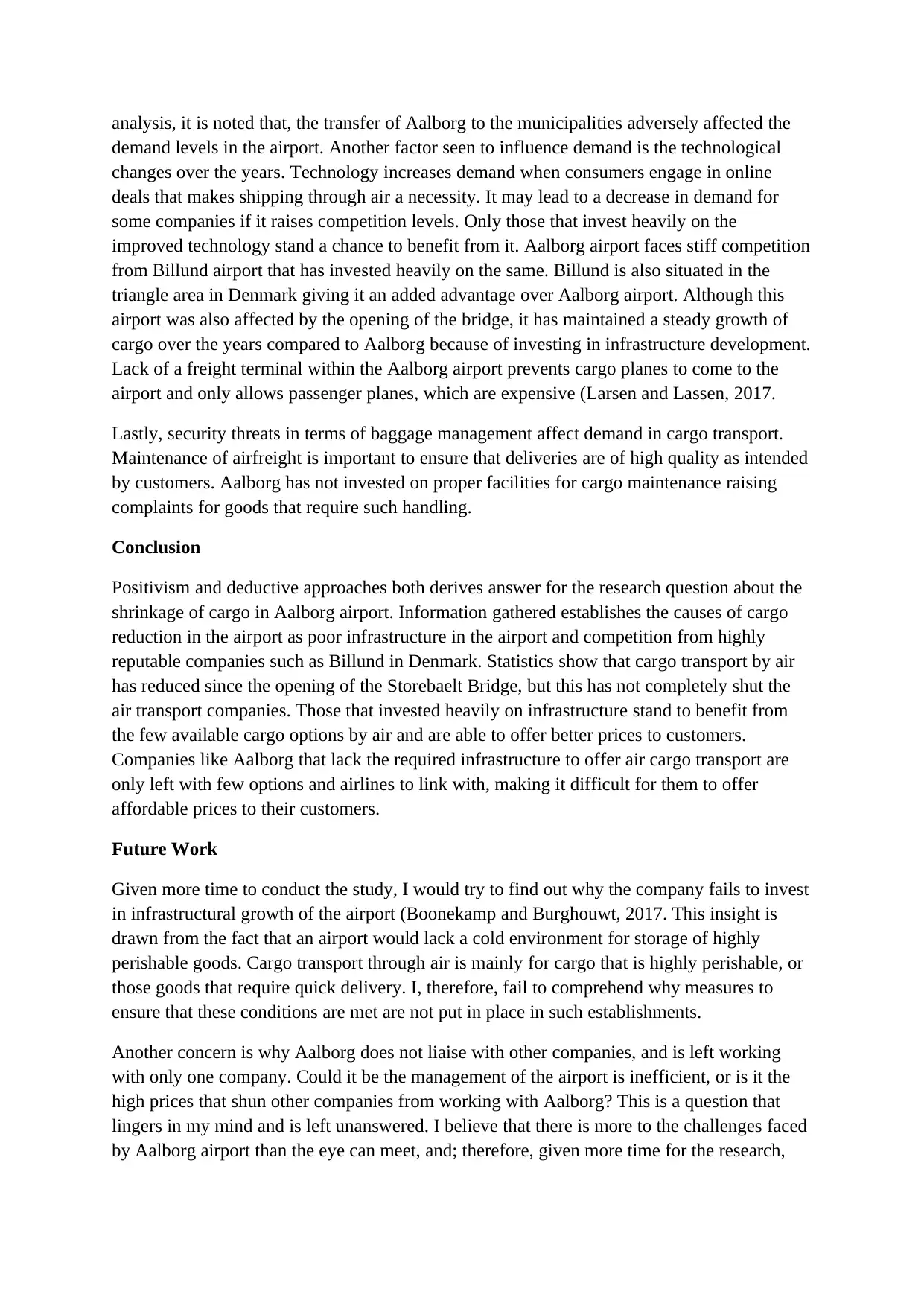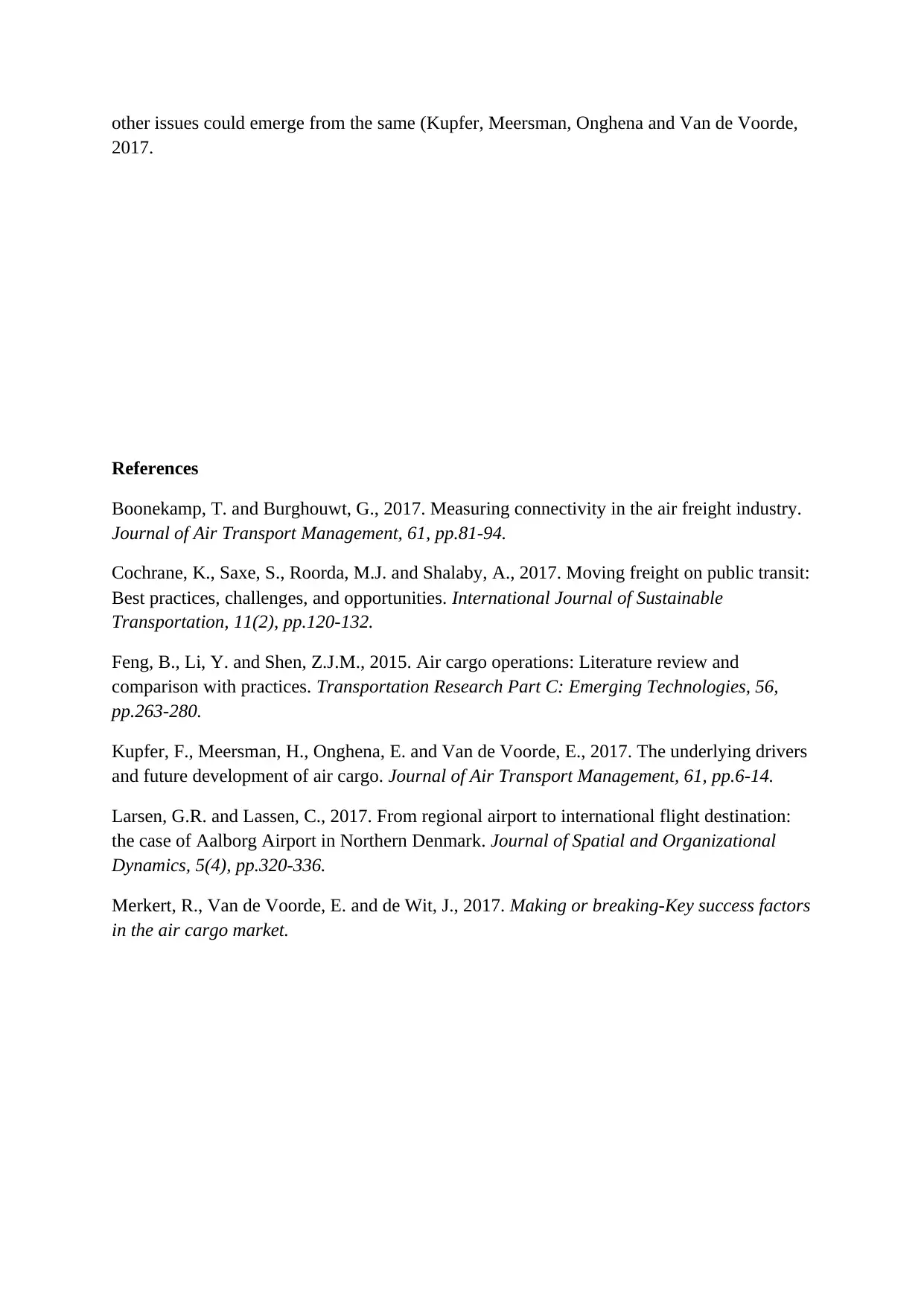MSc Mobilities Study: Analyzing Air Cargo Decline at Aalborg Airport
VerifiedAdded on 2023/06/09
|4
|1473
|377
Case Study
AI Summary
This case study investigates the decline in air cargo transport at Aalborg Airport, attributing it to factors such as poor infrastructure, increased competition from airports like Billund, and the opening of the Storebaelt Bridge. The analysis employs positivism and deductive approaches to identify the causes of cargo reduction, highlighting the impact of infrastructure investment on attracting cargo transport companies. Aalborg Airport's lack of investment in essential facilities, such as freight terminals and temperature-controlled storage, limits its ability to compete with airports offering better services and prices. The study concludes that companies investing in infrastructure development are better positioned to benefit from available cargo options, while Aalborg's limitations restrict its partnerships and pricing competitiveness. Further research is suggested to explore the reasons behind the airport's lack of infrastructural investment and its limited partnerships with other companies.

Wings to Wheels
(A study of decrease in number of goods transported by air via Aalborg Airport)
Ishita Sharma
Msc (Mobilities and Urban Studies)
(A study of decrease in number of goods transported by air via Aalborg Airport)
Ishita Sharma
Msc (Mobilities and Urban Studies)
Paraphrase This Document
Need a fresh take? Get an instant paraphrase of this document with our AI Paraphraser

Introduction
Transportation of cargo by air has facilitated trade contributing to economic development
globally and enhancement of job creation. Delivery of high quality products at competitive
prices to consumers worldwide is key in the growth of global economy (Merkert, Van de
Voorde and de Wit, 2017). Based on statistics, air cargo transport facilitates delivery of 6
trillion US dollars worth of goods, which is approximately 35% of global trade. Goods such
as vaccines and other pharmaceuticals that are temperature- sensitive are transported through
airlines helping to curb many deaths across the world (Feng, Li and Shen, 2015. Aalborg is
one among many airports that facilitate the growth of air transport and the economy at large.
The growing technology has led to a tremendous rise in the number of companies and airlines
in air transport, which increases competition. As a result, some of the airports such as
Aalborg are facing challenges of cargo decline for the last few years. There are several
reasons behind this decline ranging from skyrocketing fuel prices, competition, high security
threats within the industry, inefficient supply chains, low demand for airfreight, all of which
have slowed down the growth of cargo in Aalborg airport (Cochrane Saxe, Roorda and
Shalaby, 2017. Aalborg airport is unable to curb these challenges due to its poor
infrastructure set up. This paper seeks to discuss in details the reasons behind the shrinkage in
cargo while analysing clearly the emerging issues within the airport, and the influence of
improved infrastructure on cargo transport through air. Appropriate methodology and data
collection processes will be utilized to curb the same. Based on the study, a conclusion will
be drawn and future recommendations made.
Analysis
The review conducted reveals that there has been changes in the cargo industry leading to the
changes in demand. In the past, cargo was transported in smaller sizes making it costly with
the aim of meeting fast deliveries. Larger volumes of capital were essential, and hence only
few airlines would afford such huge capital investments. Current trends show improvements
such as development of headwinds to increase air capacity (Kupfer, Meersman, Onghena and
Van de Voorde, 2017). Despite these developments, a slow growth in air cargo transport is
noted since 2015, which creates attention for research.
The theory of demand states that demand for a commodity is influenced by several factors,
which will be discussed below. The first key determinant of demand is the price with an
increase in price leading to a low demand. Increase in fuel prices as mentioned in the review
has affected the cargo industry by shifting demand to other cheaper options. Aalborg is said
to be expensive and only used by few airlines that can afford the high costs. The fact that
demand decreases in Aalborg airport after the opening of Storebaelt Bridge connects with the
review that a shift is made to other options once consumers feel that the prices are too high.
Secondly, harsh weather conditions in North America affected the demand for air cargo
transport. The analysis shows that the demand in Aalborg airport is high in summer periods
compared to winter season. Consumers mainly trade more during the hot season than the cold
season. Thirdly, exit of some regions from the trading zone has been cited as an influence on
trade. For example, the exit of Greek from the Euro-zone affected the demand levels. In our
Transportation of cargo by air has facilitated trade contributing to economic development
globally and enhancement of job creation. Delivery of high quality products at competitive
prices to consumers worldwide is key in the growth of global economy (Merkert, Van de
Voorde and de Wit, 2017). Based on statistics, air cargo transport facilitates delivery of 6
trillion US dollars worth of goods, which is approximately 35% of global trade. Goods such
as vaccines and other pharmaceuticals that are temperature- sensitive are transported through
airlines helping to curb many deaths across the world (Feng, Li and Shen, 2015. Aalborg is
one among many airports that facilitate the growth of air transport and the economy at large.
The growing technology has led to a tremendous rise in the number of companies and airlines
in air transport, which increases competition. As a result, some of the airports such as
Aalborg are facing challenges of cargo decline for the last few years. There are several
reasons behind this decline ranging from skyrocketing fuel prices, competition, high security
threats within the industry, inefficient supply chains, low demand for airfreight, all of which
have slowed down the growth of cargo in Aalborg airport (Cochrane Saxe, Roorda and
Shalaby, 2017. Aalborg airport is unable to curb these challenges due to its poor
infrastructure set up. This paper seeks to discuss in details the reasons behind the shrinkage in
cargo while analysing clearly the emerging issues within the airport, and the influence of
improved infrastructure on cargo transport through air. Appropriate methodology and data
collection processes will be utilized to curb the same. Based on the study, a conclusion will
be drawn and future recommendations made.
Analysis
The review conducted reveals that there has been changes in the cargo industry leading to the
changes in demand. In the past, cargo was transported in smaller sizes making it costly with
the aim of meeting fast deliveries. Larger volumes of capital were essential, and hence only
few airlines would afford such huge capital investments. Current trends show improvements
such as development of headwinds to increase air capacity (Kupfer, Meersman, Onghena and
Van de Voorde, 2017). Despite these developments, a slow growth in air cargo transport is
noted since 2015, which creates attention for research.
The theory of demand states that demand for a commodity is influenced by several factors,
which will be discussed below. The first key determinant of demand is the price with an
increase in price leading to a low demand. Increase in fuel prices as mentioned in the review
has affected the cargo industry by shifting demand to other cheaper options. Aalborg is said
to be expensive and only used by few airlines that can afford the high costs. The fact that
demand decreases in Aalborg airport after the opening of Storebaelt Bridge connects with the
review that a shift is made to other options once consumers feel that the prices are too high.
Secondly, harsh weather conditions in North America affected the demand for air cargo
transport. The analysis shows that the demand in Aalborg airport is high in summer periods
compared to winter season. Consumers mainly trade more during the hot season than the cold
season. Thirdly, exit of some regions from the trading zone has been cited as an influence on
trade. For example, the exit of Greek from the Euro-zone affected the demand levels. In our

analysis, it is noted that, the transfer of Aalborg to the municipalities adversely affected the
demand levels in the airport. Another factor seen to influence demand is the technological
changes over the years. Technology increases demand when consumers engage in online
deals that makes shipping through air a necessity. It may lead to a decrease in demand for
some companies if it raises competition levels. Only those that invest heavily on the
improved technology stand a chance to benefit from it. Aalborg airport faces stiff competition
from Billund airport that has invested heavily on the same. Billund is also situated in the
triangle area in Denmark giving it an added advantage over Aalborg airport. Although this
airport was also affected by the opening of the bridge, it has maintained a steady growth of
cargo over the years compared to Aalborg because of investing in infrastructure development.
Lack of a freight terminal within the Aalborg airport prevents cargo planes to come to the
airport and only allows passenger planes, which are expensive (Larsen and Lassen, 2017.
Lastly, security threats in terms of baggage management affect demand in cargo transport.
Maintenance of airfreight is important to ensure that deliveries are of high quality as intended
by customers. Aalborg has not invested on proper facilities for cargo maintenance raising
complaints for goods that require such handling.
Conclusion
Positivism and deductive approaches both derives answer for the research question about the
shrinkage of cargo in Aalborg airport. Information gathered establishes the causes of cargo
reduction in the airport as poor infrastructure in the airport and competition from highly
reputable companies such as Billund in Denmark. Statistics show that cargo transport by air
has reduced since the opening of the Storebaelt Bridge, but this has not completely shut the
air transport companies. Those that invested heavily on infrastructure stand to benefit from
the few available cargo options by air and are able to offer better prices to customers.
Companies like Aalborg that lack the required infrastructure to offer air cargo transport are
only left with few options and airlines to link with, making it difficult for them to offer
affordable prices to their customers.
Future Work
Given more time to conduct the study, I would try to find out why the company fails to invest
in infrastructural growth of the airport (Boonekamp and Burghouwt, 2017. This insight is
drawn from the fact that an airport would lack a cold environment for storage of highly
perishable goods. Cargo transport through air is mainly for cargo that is highly perishable, or
those goods that require quick delivery. I, therefore, fail to comprehend why measures to
ensure that these conditions are met are not put in place in such establishments.
Another concern is why Aalborg does not liaise with other companies, and is left working
with only one company. Could it be the management of the airport is inefficient, or is it the
high prices that shun other companies from working with Aalborg? This is a question that
lingers in my mind and is left unanswered. I believe that there is more to the challenges faced
by Aalborg airport than the eye can meet, and; therefore, given more time for the research,
demand levels in the airport. Another factor seen to influence demand is the technological
changes over the years. Technology increases demand when consumers engage in online
deals that makes shipping through air a necessity. It may lead to a decrease in demand for
some companies if it raises competition levels. Only those that invest heavily on the
improved technology stand a chance to benefit from it. Aalborg airport faces stiff competition
from Billund airport that has invested heavily on the same. Billund is also situated in the
triangle area in Denmark giving it an added advantage over Aalborg airport. Although this
airport was also affected by the opening of the bridge, it has maintained a steady growth of
cargo over the years compared to Aalborg because of investing in infrastructure development.
Lack of a freight terminal within the Aalborg airport prevents cargo planes to come to the
airport and only allows passenger planes, which are expensive (Larsen and Lassen, 2017.
Lastly, security threats in terms of baggage management affect demand in cargo transport.
Maintenance of airfreight is important to ensure that deliveries are of high quality as intended
by customers. Aalborg has not invested on proper facilities for cargo maintenance raising
complaints for goods that require such handling.
Conclusion
Positivism and deductive approaches both derives answer for the research question about the
shrinkage of cargo in Aalborg airport. Information gathered establishes the causes of cargo
reduction in the airport as poor infrastructure in the airport and competition from highly
reputable companies such as Billund in Denmark. Statistics show that cargo transport by air
has reduced since the opening of the Storebaelt Bridge, but this has not completely shut the
air transport companies. Those that invested heavily on infrastructure stand to benefit from
the few available cargo options by air and are able to offer better prices to customers.
Companies like Aalborg that lack the required infrastructure to offer air cargo transport are
only left with few options and airlines to link with, making it difficult for them to offer
affordable prices to their customers.
Future Work
Given more time to conduct the study, I would try to find out why the company fails to invest
in infrastructural growth of the airport (Boonekamp and Burghouwt, 2017. This insight is
drawn from the fact that an airport would lack a cold environment for storage of highly
perishable goods. Cargo transport through air is mainly for cargo that is highly perishable, or
those goods that require quick delivery. I, therefore, fail to comprehend why measures to
ensure that these conditions are met are not put in place in such establishments.
Another concern is why Aalborg does not liaise with other companies, and is left working
with only one company. Could it be the management of the airport is inefficient, or is it the
high prices that shun other companies from working with Aalborg? This is a question that
lingers in my mind and is left unanswered. I believe that there is more to the challenges faced
by Aalborg airport than the eye can meet, and; therefore, given more time for the research,
⊘ This is a preview!⊘
Do you want full access?
Subscribe today to unlock all pages.

Trusted by 1+ million students worldwide

other issues could emerge from the same (Kupfer, Meersman, Onghena and Van de Voorde,
2017.
References
Boonekamp, T. and Burghouwt, G., 2017. Measuring connectivity in the air freight industry.
Journal of Air Transport Management, 61, pp.81-94.
Cochrane, K., Saxe, S., Roorda, M.J. and Shalaby, A., 2017. Moving freight on public transit:
Best practices, challenges, and opportunities. International Journal of Sustainable
Transportation, 11(2), pp.120-132.
Feng, B., Li, Y. and Shen, Z.J.M., 2015. Air cargo operations: Literature review and
comparison with practices. Transportation Research Part C: Emerging Technologies, 56,
pp.263-280.
Kupfer, F., Meersman, H., Onghena, E. and Van de Voorde, E., 2017. The underlying drivers
and future development of air cargo. Journal of Air Transport Management, 61, pp.6-14.
Larsen, G.R. and Lassen, C., 2017. From regional airport to international flight destination:
the case of Aalborg Airport in Northern Denmark. Journal of Spatial and Organizational
Dynamics, 5(4), pp.320-336.
Merkert, R., Van de Voorde, E. and de Wit, J., 2017. Making or breaking-Key success factors
in the air cargo market.
2017.
References
Boonekamp, T. and Burghouwt, G., 2017. Measuring connectivity in the air freight industry.
Journal of Air Transport Management, 61, pp.81-94.
Cochrane, K., Saxe, S., Roorda, M.J. and Shalaby, A., 2017. Moving freight on public transit:
Best practices, challenges, and opportunities. International Journal of Sustainable
Transportation, 11(2), pp.120-132.
Feng, B., Li, Y. and Shen, Z.J.M., 2015. Air cargo operations: Literature review and
comparison with practices. Transportation Research Part C: Emerging Technologies, 56,
pp.263-280.
Kupfer, F., Meersman, H., Onghena, E. and Van de Voorde, E., 2017. The underlying drivers
and future development of air cargo. Journal of Air Transport Management, 61, pp.6-14.
Larsen, G.R. and Lassen, C., 2017. From regional airport to international flight destination:
the case of Aalborg Airport in Northern Denmark. Journal of Spatial and Organizational
Dynamics, 5(4), pp.320-336.
Merkert, R., Van de Voorde, E. and de Wit, J., 2017. Making or breaking-Key success factors
in the air cargo market.
1 out of 4
Related Documents
Your All-in-One AI-Powered Toolkit for Academic Success.
+13062052269
info@desklib.com
Available 24*7 on WhatsApp / Email
![[object Object]](/_next/static/media/star-bottom.7253800d.svg)
Unlock your academic potential
Copyright © 2020–2025 A2Z Services. All Rights Reserved. Developed and managed by ZUCOL.





